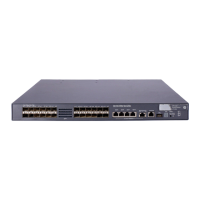144
Figure 61 Management/member device state change
• After a cluster is created, a candidate device is added to the cluster and becomes a member device,
the management device saves the state information of its member device and identifies it as Active.
And the member device also saves its state information and identifies itself as Active.
• After a cluster is created, its management device and member devices begin to send handshake
packets. Upon receiving the handshake packets from the other side, the management device or a
member device simply remains its state as Active, without sending a response.
• If the management device does not receive the handshake packets from a member device in an
interval three times of the interval to send handshake packets, it changes the status of the member
device from Active to Connect. Likewise, if a member device fails to receive the handshake packets
from the management device in an interval three times of the interval to send handshake packets,
the status of itself will also be changed from Active to Connect.
• If this management device, in information holdtime, receives the handshake or management packets
from its member device which is in Connect state, it changes the state of its member device to Active;
otherwise, it changes the state of its member device to Disconnect, in which case the management
device considers its member device disconnected. If this member device, which is in Connect state,
receives handshake or management packets from the management device in information holdtime, it
changes its state to Active; otherwise, it changes its state to Disconnect.
• If the communication between the management device and a member device is recovered, the
member device which is in Disconnect state will be added to the cluster. After that, the state of the
member device locally and on the management device will be changed to Active.
• A member device informs the management device using handshake packets when there is a
neighbor topology change.
Management VLAN
The management VLAN is a VLAN used for communication in a cluster; it limits the cluster management
range. Through configuration of the management VLAN, the following functions can be implemented:
• Management packets— including NDP, NTDP and handshake packets— are restricted within the
management VLAN, and isolated from other packets, which enhances security.
• The management device and the member devices communicate with each other through the
management VLAN.

